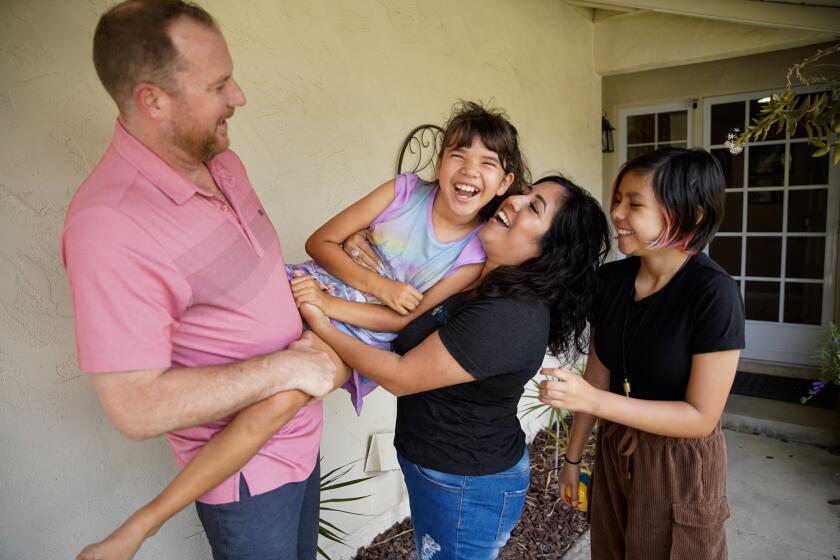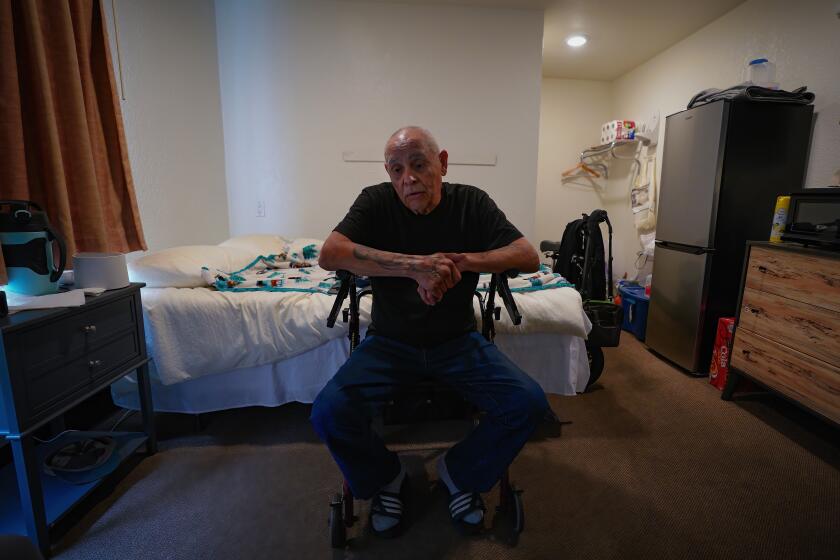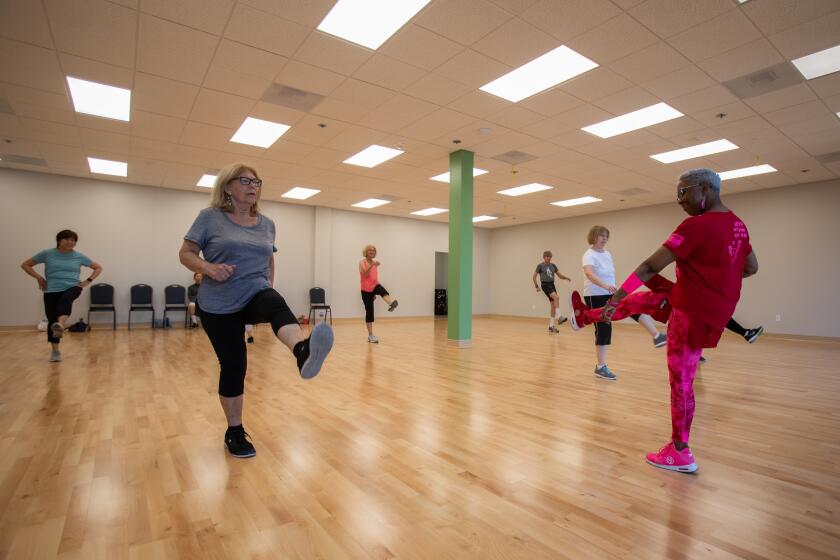You really want to pet the service dog. Here’s why it’s so important not to
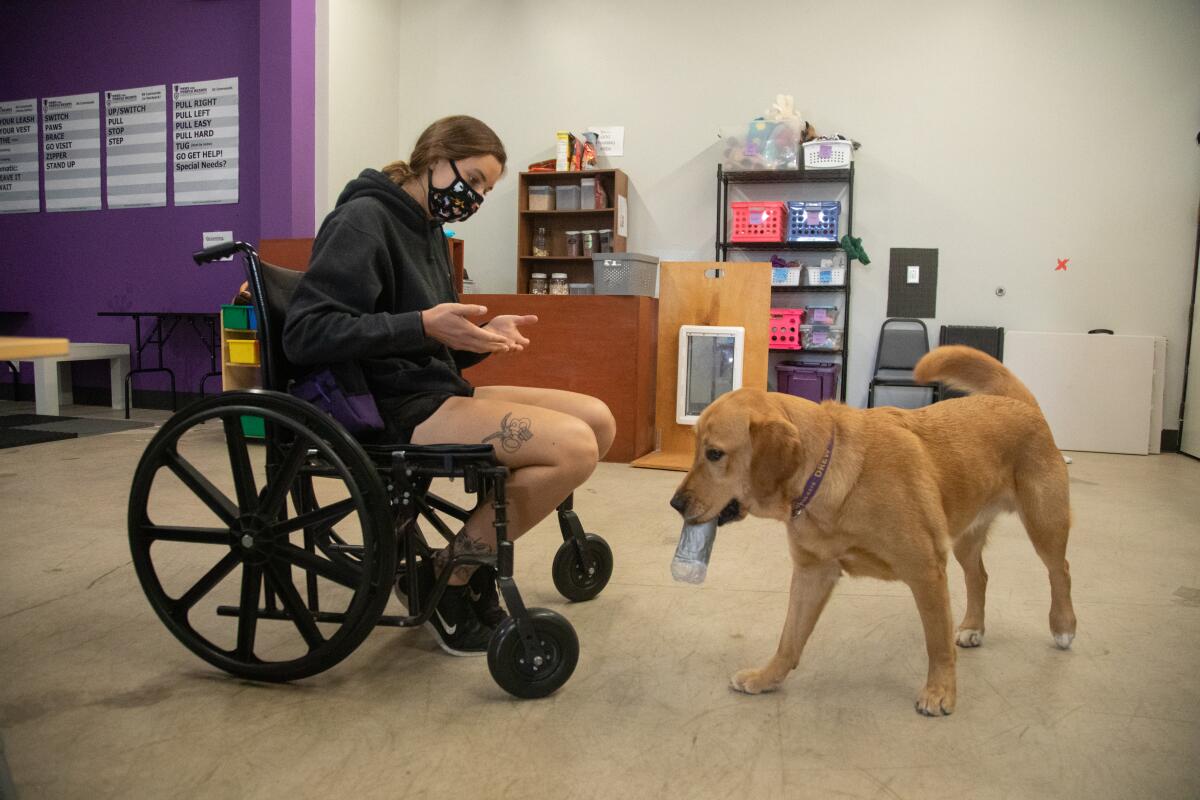
Life-changing canines are trained to play a vital role for people who depend on them, without distraction
Service dogs are a vital tool for the approximately 500,000 Americans who are partnered with them, and when out in public, they’re working diligently to keep their human handlers safe.
That can mean keeping people with limited vision from walking into oncoming traffic or helping someone in a wheelchair pick up an object. For dogs paired with someone living with an invisible illness like post-traumatic stress disorder, service dogs use calming techniques when they detect signs of anxiety.
But despite the important role these dogs play in the safety and comfort of their humans, it doesn’t stop some people from trying to distract or play with them when they see one.
“A lot of times, having a service dog kind of puts a spotlight on you when you’re out in public, and not everyone loves that,” said Kaitlyn Sacco, a trainer with Paws for Purple Hearts.
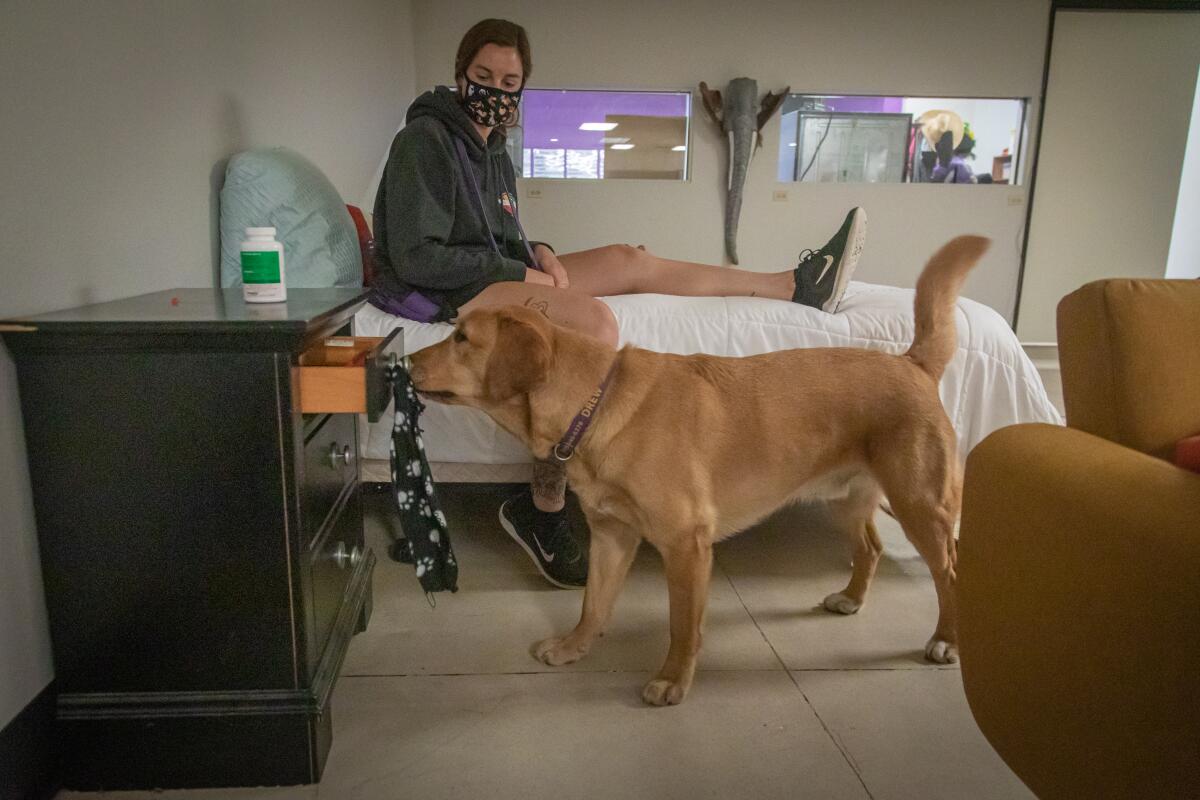
Distractions can endanger people who depend on service animals, such as Carlsbad resident Jill Anderson, 57, who has lost most of her vision due to a retinitis pigmentosa (a rare, inherited eye disease) and macular degeneration. Because of these two conditions, she is unable to see at night and has tunnel vision and very limited depth perception during the day.
Anderson started experiencing symptoms of the eye disease at 17 but was able to see well enough to drive until six years ago, when she started regularly injuring herself by tripping or running into objects like light poles and walls. The increasingly limited vision impacted Anderson’s confidence, causing her to feel unsure of herself and stay home more often.
“I could still run if I could get somebody to go with me, but I couldn’t see, so I couldn’t be independent and feel free,” Anderson said.
With her vision now severely impacted, she has worked with a guide dog, a yellow Labrador retriever named Kirby, to navigate through the world for the past three years. Having a guide dog to help her cross intersections and walk around has allowed Anderson to reclaim a lot of the independence she lost as her vision deteriorated.
But she said their relationship isn’t magical: It was built through months of training to decrease vulnerability to distractions.
Too often, though, people try to pet, call over, distract or play with Kirby while they are in public, which jeopardizes the safety of both of them.
“You sort of have to have thick skin and be ready for it because, like anybody with a disability, you have to be ready to face these difficulties,” Anderson said. “It’s an uphill climb if you want to get out and try to be in mainstream life.”
Strangers who approach someone working with a service dog can sometimes trigger memories of traumatic events.
U.S. Marine Corps veteran Jessica Belcher was working in an armory at Camp Pendleton and was sexually assaulted by a fellow Marine. She struggled to recover mentally from the incident and was medically retired because of it in March 2019.
“It was hard to be around other Marines at that point and just be able to trust them,” Belcher said.
Following the assault, her active lifestyle halted. Belcher started self-isolating at home, stopped going to the grocery store and was no longer interacting with people. Even the anticipation of going to a doctor’s appointment gave her nightmares.

“It was rough,” she recalled. “My symptoms of PTSD were kind of taking over my life.”
After researching how a service animal could help her, the 23-year-old Oceanside resident was linked up with a black Labrador retriever named Lucy last June, and the pair graduated from training in October 2020.
Working with a service animal has improved Belcher’s mood, made her happier and helped her to somewhat return to who she was before the assault. On days when she experiences back and knee pain, Lucy can help Belcher by picking up items like her leash.
Lucy also helped her to feel comfortable flying on a plane again to visit her newborn nephew, and she is now working at the doggy day care of an animal hospital.
“I feel safer having her — she wakes me up from my nightmares, so I don’t have to dread going to sleep anymore,” Belcher said. “I love having her with me, she completely changed my life and I love her so much.”
But when strangers — especially men — approach them, it makes Belcher very uncomfortable.
“I don’t really like people coming up and asking questions, and I want my space,” she said. “It doesn’t matter what I have on her vest — ‘do not distract,’ ‘do not pet,’ ‘do not approach’ — people do it anyways.”
What is — and isn’t — a service dog
When it comes to dogs and the way they support humans with various physical, mental, developmental and emotional conditions, there are two types: service dogs and guide dogs.
Service dogs are specially trained to work with and perform tasks for people living with a physical, mental, sensory, intellectual, learning or psychiatric disability, according to Guide Dogs of America. Their training includes physical tasks such as learning to pick up objects, opening doors, turning light switches on and off, and it may also include behaviors aiming to disrupt symptoms of anxiety and stress.
They can also be trained to accompany children diagnosed with autism spectrum disorder to reduce stress, anxiety and meltdowns, said Zack Gittlen, marketing and outreach manager for Guide Dogs of America.

“They might nudge their nose into the child’s leg or rest their chin on their lap, and they’re there for a grounding sensory response,” Gittlen said.
Guide dogs are specifically trained to work with those who are blind or have limited vision by helping them to avoid traffic, navigate elevation changes and avoid obstacles.
People with visual impairments take classes with an orientation and mobility instructor and then are evaluated to ensure they’re able to navigate using sensory awareness before being paired with a guide dog.
Most often, but not always, service dogs are either golden retrievers, Labrador retrievers or a mix of the two breeds.
“They are the perfect temperament for this type of work,” Sacco said. “They’re not too independent; they’re not too assertive; they’re very eager to please and loyal, and easy to train.”
Service and guide dogs are considered necessary medical equipment, akin to a wheelchair, crutches, an insulin pump or other necessary health care tool. They are allowed to go to any business that is open to the public, according to Americans with Disabilities Act (ADA) regulations. This includes — but is not limited to — grocery and department stores, restaurants, hospitals and medical offices, hotels, taxis, theaters, zoos and parks.
Conversely, emotional support animals — used to ease feelings of anxiety and depression through companionship — don’t qualify as service animals under the ADA. They may be denied access to public places, including planes, per a December 2020 decision from the U.S. Department of Transportation.
Under state and federal law, tenants have the right to have an emotional support animal in their home if it “eases the effects of a person’s disability by providing comfort,” according to Disability Rights California.
How service dogs are trained
Training is required for both the dog and the handler who will be teamed up with them. Depending on the organization, sometimes the bulk of training is conducted by staff and volunteers, then the individual works with them for a few weeks at the end.
This is true at Paws for Purple Hearts, a nonprofit that trains and gives free service animals to military veterans who have suffered from a physical disability, PTSD, military sexual trauma, traumatic brain injury or other trauma.
Throughout most of the training, dogs work on-site with professional trainers, who have graduated from the Bergin University of Canine Studies in Northern California.
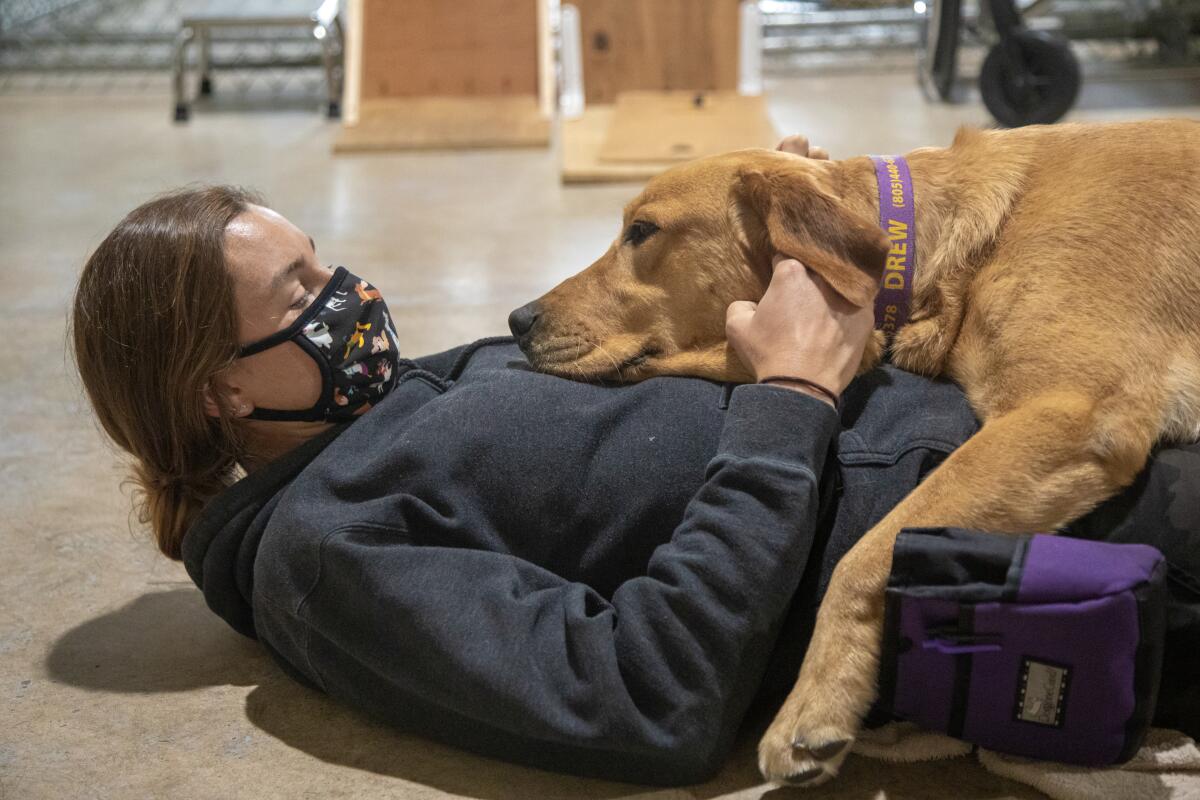
The dogs both learn to both perform physical tasks and detect signs of anxiety — like a shaking leg — as well as ways to reduce stress by nudging the person or using their body weight to lay on them. Trainers also take the dogs on field trips to public places so they can learn to ignore distractions.
Training lasts until the dogs are about 2 or 3 years old, trainer Selah Marting said. If they pass their assessment, they’re paired with a veteran for two final weeks of training on-site, where they learn how to handle and use a service dog.
After they pass an assessment, handlers are paired with a guide dog who can match their walking style, activity level and overall lifestyle. The guide dog team then has three additional weeks of on-campus training together, while for a service dog, the handler has three weeks of online training before working with their dog for a week in person.
Belcher worked hands-on training service dogs for about 11 months at Next Step Service Dogs, an Escondido nonprofit that trains dogs for veterans with PTSD, a traumatic brain injury and/or military sexual trauma. At first, she worked with one dog who turned out to be too low-key for her before pairing with Lucy, who has a more compatible energy level.
“I wanted a dog that would encourage me to get out more and do more things, and she definitely fits that for me,” Belcher said.
In some cases, people train their own dogs, like 16-year-old Lakeside resident Sam Stewart, who said she didn’t qualify for a free service dog program because she’s neither blind nor a veteran.
After searching multiple shelters and rescue facilities looking for a calm dog, Stewart found Indy, a border collie mix. With help from friends who are dog trainers and other people online, she has learned to self-train him over the past year.
Stewart has physical health conditions that impact her daily living, including sciatica in her hips, tendinitis in both knees and Osgood-Schlatter disease in her right knee, which causes pain and swelling. When she is stuck in a sitting position, Indy can now help her get up. She also has a dissociative disorder, a mental health condition where someone involuntarily retreats from reality.
In these situations, Stewart grabs the guide handle attached to Indy’s harness and he guides her to her mom or a less crowded place. He’ll also lay on her, using his body like a weighted blanket to do deep pressure therapy and calm Stewart’s anxiety, as well as prevent behaviors of self-harm.
“It’s actually gone down a lot since then with just the reassurance that Indy is there,” she said.
Sometimes, people approach her to pet or talk about her dog while she is in a dissociative state, complicating an already stressful situation.
Having cards to hand out with parts of the ADA law and information about Indy helps Stewart if someone approaches them when she’s in a dissociative state and nonverbal.
“A lot of people don’t understand the impact you can have when you interact with a service dog without permission and the effect that can have directly on the handler by distracting them,” Stewart said. “You never know what disability they have — plenty of disabilities are invisible.”
What to do when you see a guide dog
Dog trainers and advocates from Paws for Purple Hearts and Guide Dogs of America say it’s always best to keep the following guidance in mind when you see a guide or service dog in public:
Where are they allowed to go? Service dogs are allowed to go to any public place with the humans they’re partnered with. That means you’ll see them at the grocery store, amusement parks, courthouses, doctor’s offices and pretty much everywhere else.
Don’t approach or pet a service dog. They’re trained to stay attuned to the needs of their human, so petting or playing with them can distract them from their job. If you’re interested in learning more, make sure to address the person first and always ask for permission before interacting with their service animal.
How can I tell if it’s a service dog? There are many reasons people are paired with a trained dog, and some reasons aren’t visible in public. You can tell that a dog is a service or guide animal based on the harness it wears, which may have a handle or state that they’re a guide or service dog.
Never take hold of a leash or harness from a service dog handler — doing so can disorient the handler, the dog or both. Only do so if the handler asks for your assistance.
If you see a service dog wandering alone, its handler may be in trouble. Follow the dog back to its owner to make sure they’re OK.
Always remember that guide and service dog teams legally have the right of way. If you’re driving, don’t honk or yell at a working guide or service dog and their handler — this can distract the dog and put the person at risk.
Get CaregiverSD in your inbox on Mondays
Helpful tips, information and resources from caregiverSD.com in your inbox Monday mornings.
You may occasionally receive promotional content from the San Diego Union-Tribune.



